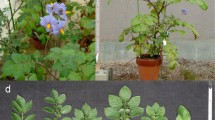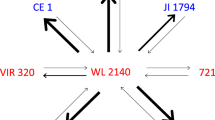Summary
The purpose of this study was to determine female and male fertility, and self-compatibility within 26 families derived from inter-mating the F1 hybrids from the cross,S. phureja-haploidS. tuberosum. The F1 hybrids involved 5S. phureja selections (P.I.’s 195198, 225685, 225696, 243462, 243466) and 2 haploids (US-W 1 from Katahdin and US-W 42 from Chippewa).
Fertility tests were made in the field, greenhouse and laboratory. Female fertility tests were carried out in the field. Bulked pollen of five or more plants was used in order to pollinate each plant in the family. Male fertility was tested by pollen shedding, pollen germination and controlled sib-matings in the field. Self-compatibility tests were made in an air-conditioned greenhouse using the decapitation technique.
Sixty-three percent of the plants were female fertile and77% were male fertile. Pollen-shed was an efficient method of determining male fertility in these materials. A low level of pseudo self-compatibility occurred.
The vigor of most plants, the high frequency of flowering, and the high incidence of female and male fertility indicated that this material will be useful in exploring potato breeding at the diploid level as well as in genetic and cytogenetic studies.
Similar content being viewed by others
Literature Cited
Cipar, M. S., S. J. Peloquin, and R. W. Hougas. 1964. Variability in the expression of self-incompatibility in tuber-bearing diploidSolanum species. Am. Potato J. 41: 155–162.
Gabert, A. C. 1963. Factors influencing the frequency of haploids in the common potato (Solanum tuberosum). Ph.D. Thesis, University of Wisconsin.
Hawkes, J. G. 1958. Significance of wild species and primitive forms for potato breeding. Euphytica 7:257–270.
Hougas, R. W. and S. J. Peloqin. 1960. Crossability ofSolanm tuberosum haploids with diploidSolanum species. Europ. Potato J. 3: 325–330.
Howard, H. W. 1961. Potato cytology and genetics. Bibliographia Genetica 19: 187–216.
Peloquin, S. J. and R. W. Hougas. 1959. Decapitation and genetic markers as related to haploidy inSolanum tuberosum. Europ. Potato J. 2: 176–183
Peloquin, S. J., L. R. Mortenson and R. W. Hougas. 1961. Germination ofSolanum pollen on artificial media. Am. Potato J. 38:370–371 (Abs.).
Ross, R. W., S. J. Peloquin and R. W. Hougas. 1962. Fertility of diploid hybrids fromS. phureja-haploidS. tuberosum matings. Am. Potato J. 39: 395 (Abs.).
Swaminathan, M. S. and H. W. Howard. 1953. The cytology and genetics of the potato (Solanum tuberosum) and related species. Biblio. Genetica 16: 1–192.
Author information
Authors and Affiliations
Additional information
Formerly Rockefeller Foundation Scholar, Department of Horticulture, University of Wisconsin
Rights and permissions
About this article
Cite this article
Perez-Ugalde, G., Hougas, R.W. & Peloquin, S.J. Fertility of S. phureja-haploid S. tuberosum F2 hybrids. American Potato Journal 41, 256–262 (1964). https://doi.org/10.1007/BF02855156
Accepted:
Issue Date:
DOI: https://doi.org/10.1007/BF02855156




